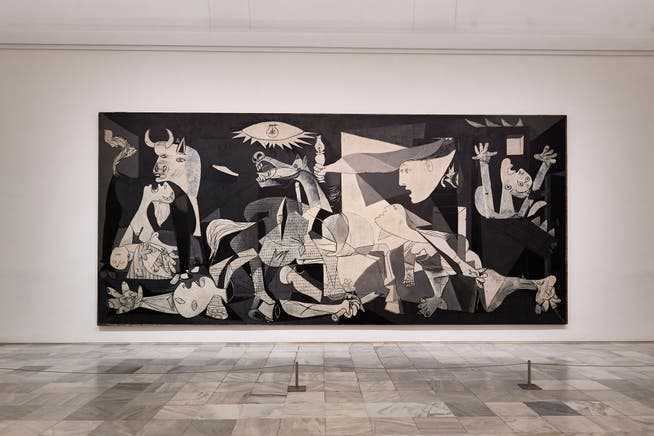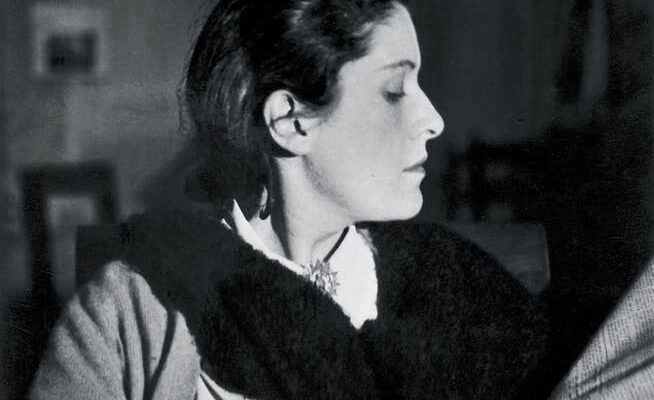Dora Maar allowed herself to be humiliated in her toxic relationship with her master, but not destroyed. Instead, as a muse and model, she drove Picasso to create the painting “Guernica”. A new biography shows the relationship, which is as productive as it is destructive – and how it is processed.
Dora Maar’s address book reads like a directory of the Paris surrealist scene. Picasso sorted them out in it. Photo from the winter of 1935/1936.
It is said that Picasso destroyed Dora Maar. For eight years, from 1936 to 1944, this woman was his muse and partner. She was actively involved in his most famous work, «Guernica». Then Picasso threw them away. This narrative is common, but it is not entirely true, it is incomplete and one-sided. Dora Maar herself brought a strong sense of self-harm to the relationship with Picasso.
It began with a bloody staging in a Parisian restaurant «Les Deux Magots». Dora Maar stabbed her own fingers with a knife, injuring herself to get Picasso’s attention. She wore leather gloves, according to eyewitnesses they were black, maybe white – the blood would show up better on white. In any case, Picasso exhibited the punctured and smeared gloves in his studio.
«Dora Maar had a strong masochistic component. She was attracted to sadistic men, she sought submission and suffering. With her Picasso was even more sadistic than with other women. He was a monster, terrible, cruel, devilish. So he was against women and men, but especially with Dora.” This is what Brigitte Benkemoun, the author of a new biography of Dora Maar, recently published in German, says on the phone (“The address book of Dora Maar”, BTB-Verlag, Munich 2021).
Photographing in the workshop of the genius
In the painting “Guernica” Dora Maar is present several times, she played a decisive role in it. “She drove Picasso to this picture, she politicized him,” says Benkemoun. In fact, he initially had great trouble with this state contract from the Spanish Republic. He lacked the brilliant idea how preliminary studies reveal. Only the reports on the bombing of April 26, 1937 provided the topic.

“Guernica” in the Museo Reina Sofia in Madrid.
It is possible that Dora Maar is the torchbearer in the center of the painting “Guernica”, but this attribution is speculative. The central female figure is only indicated in outline, she has no recognizable face. What is documented, however, is that Dora Maar herself put a hand on the picture, with a brush and paint, even if only marginally. She applied the hatchings of the dying horse when the master was exhausted.
Picasso worked on the picture for a month, the whole time Dora Maar was there. She captured the creative process with the camera, the most important stages are in the “Guernica” room of the Reina Sofia Museum documented in Madrid. Their recordings gave the painter a better overview of the large format picture he was creating. They also showed the artist in action, the genius in front of his work in progress. They were quickly published, thereby contributing to the fame of the picture and its creator.
“It was a toxic relationship between the two,” says Benkemoun. Dora Maar, born Henriette Theodora Markovitch in 1907, was 25 years younger than Picasso. He valued her intelligence, he used her as a wife and model. He tormented her, he painted her, her face distorted and disfigured in a cubist or surrealist manner. One never forgets these portraits, like “Guernica” they too belong to the collective pictorial memory of modernity. They fetch tens of millions at auction.
Before her liaison with Picasso, Dora Maar was a top fashion photographer from an early age. She increasingly turned to social reporting. Instead of beautiful models in expensive clothes, she portrayed beggars and the unemployed. “She travelled, she was independent, a free woman,” says Benkemoun. And she experimented in the lab, with multiple exposures and collage. She alienated faces herself, years before Picasso distorted her own face while painting.
“Picasso was small, not beautiful, but he must have had an enormous charisma,” says Benkemoun. In any case, Dora Maar felt attracted. She gave up photography to devote herself to painting. It is said that Picasso caused her to end her career. Benkemoun rejects this thesis. At that time, photography was not yet recognized as an art form, but Dora Maar wanted to be considered an artist. Of her own accord she decided to paint and not to photograph.
survival after separation
In 1944 Picasso ousted Dora Maar, she had served her time. She ended up in a psychiatric hospital for a short time and was treated with electric shocks – that was considered the state of the art at the time, an ordeal. She was being treated by the famous psychoanalyst Jacques Lacan. He often fell asleep during the sessions, after which he took the patient out to the restaurant. “He sees no problem at all in moving from the couch to the table,” Benkemoun notes in her book. Picasso paid for the sessions and also bought a house in Provence for his beloved.
Gradually Dora Maar got to her feet, she painted, she dared to socialize. In 1951 she opened a new address book. It reads like a directory of the Paris Surrealist scene, but Picasso has been sorted out. The little book came to Brigitte Benkemoun by chance. She saw his potential. In over forty profiles, she traces Dora Maar’s friends and acquaintances, she follows the threads of a dense network of relationships, illuminates the main and secondary characters from changing perspectives.
Dora Maar gave up therapy with Lacan and found a new guru, the priest Jean de Monléon. “Within a few weeks she slips from the couch into the confessional,” writes Benkemoun. The artist becomes a bigot, she is increasingly bitter, only a few confidants remain. She distances herself from the world, she no longer lets anyone into the house, and she also becomes an enemy of Jews and gays. Under her bed are portraits that Picasso once painted of her. Benkemoun writes that she never breaks away from the character that Picasso has made of her.
Red fingernails signal the woman of the world
“You will have to cut, combine, guess,” writes Benkemoun at the heart of her book. She takes the liberty of filling in gaps in the overall picture. She is aware of the dangers of such – always declared – digressions into the conjectural, but empathy does not rule out objectivity. The phone number of a beauty salon is also in the address book. Bright red fingernails were a trademark of Dora, and they are immortalized in numerous portraits. The biographer does not miss such characteristic details.
Picasso put the label “the weeping woman” on Dora Maar, and it stuck to her. She was a strong and proud woman, a challenge for Picasso, intellectual and erotic. Master has reduced them to a heap of misery. But she did not commit suicide like two other companions of the genius. She caught herself, she survived. She never found her way back to her old self-confidence. In 1990 she had her last exhibition of her own paintings, in 1997 she died in Paris.
«Picasso and the women – The master of the game.»
Brigitte Benkemoun: «The address book of Dora Maar». BTB-Verlag, Munich 2021, 288 pages, 12 euros.
